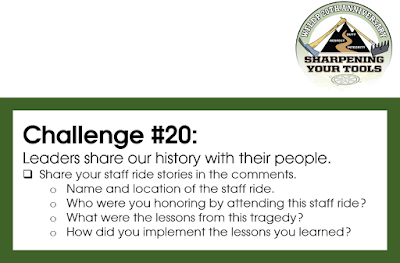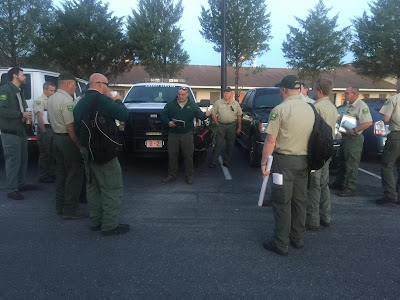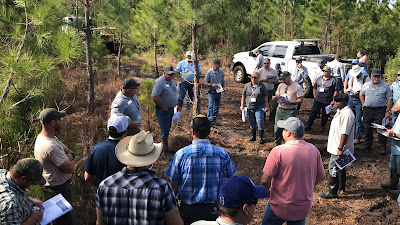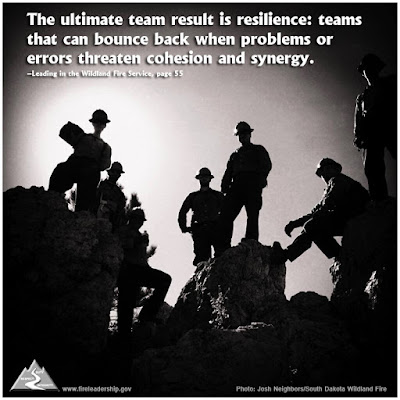A forum where students of fire and leadership come together to discuss, debate and exchange leadership development concepts, experience, and thoughts with an intent to promote cultural change in the workforce and strengthen the wildland fire service and the communities they serve.
Monday, May 31, 2021
IGNITE: Honoring Our Fallen
Saturday, May 29, 2021
Knowing Our People and Looking Out for Their Well-Being
The wildland fire service approach to taking care of people encompasses mind, body, and spirit. Because duty can take our people into dangerous situations, fire leaders reciprocate their loyalty by looking out for their safety and well-being in all circumstances.
Leaders learn about people as individuals, developing an understanding of what motivates them and how they derive satisfaction from their work. We consider how stress and fear can affect our people’s well-being and take steps to understand and mitigate the effects of these human factors.
[Click here to download a copy of Leading in the Wildland Fire Service.]
Friday, May 28, 2021
Challenge #21: 2021 WFLDP Campaign
Challenge #21: Leaders learn from tragedies of the past.
- Visit the Staff Ride Library at https://www.nwcg.gov/wfldp/toolbox/staff-ride/library.
- Select at least one tragedy to review.
- Take notes in your journal about the tragedy.
- What behavior will you change because of this event?
Thursday, May 27, 2021
IGNITE: Recognition Before an Emergency
One of the true tests of leadership is the ability to recognize a problem before it becomes an emergency. - Arnold Glasgow
[Photo: Team Wildland Firefighter]
Wednesday, May 26, 2021
Respect: Taking Care of People
To gain respect from our people, we first respect them. Leaders demonstrate respect for our people in many ways: by getting to know them, by looking out for their well-being, by keeping them informed, by putting forth the effort to build strong teams, and by employing them in accordance with their capabilities.
Mission success or failure often hinges on our ability to understand each other and work together. Whether merging a diverse group of people as a team or dealing with the aftermath of a tragic event, understanding human behavior is inherent to being a good leader.
[Click here to download a copy of Leading in the Wildland Fire Service.]
Tuesday, May 25, 2021
Challenge #20: 2021 WFLDP Campaign

Challenge #20: Leaders share our history with their people.
- Share your staff ride stories in the comments.
- Name and location of the staff ride.
- Who were you honoring by attending this staff ride?
- What were the lessons from this tragedy?
- How did you implement the lessons you learned?
Monday, May 24, 2021
IGNITE: The Seeds of Lessons Learned
[Photo: Kyle Miller/Wyoming IHC]
Saturday, May 22, 2021
Summary - Duty
Duty is how we value our job.
Duty begins with everything required of us by law and policy, but it is much more than that. As leaders, we commit to excellence in all aspects of our professional responsibility so that when a job is done we can look back and say I couldn’t have given any more.
- Be proficient in your job, both technically and as a leader.
- Make sound and timely decisions.
- Ensure tasks are understood, supervised, and accomplished.
- Develop your people for the future.
[Click here to download a copy of Leading in the Wildland Fire Service.]
Wednesday, May 19, 2021
After Action Review - Stories From the Fireline
A division consisting of five handcrews had been assigned to a fire in a wilderness area. The firefighters on the division had to hike for two hours, through rough terrain, to get to the fire. There they began working on their assignment: construct indirect handline, fire it out, and hold it.
Monday, May 17, 2021
Staff Ride/Case Study/Site Visit - What's the Difference?
IGNITE: Be Ever Aware of the Lessons Learned
May we all be energized and inspired to be ever aware of the lessons learned from their sacrifice." - South Canyon Fire Investigation Team, August, 1994
[Photo: Kari Greer/USFS]
#neverforget #honorthroughlearning
Saturday, May 15, 2021
After Action Reviews (AARs)
AARs allow people to share honest opinions and learn from each other. Fire leaders make sure that debriefings focus on what instead of who; we use them to improve weaknesses and to sustain strengths.
Friday, May 14, 2021
Challenge 19 - 2021 WFLDP Campaign
How would you describe your organizational culture?
- Is it a place that welcome new employees from day one?
- Is your organization a place that leverages everyone's diverse backgrounds and thinking?
- Is this the senior leader’s primary job?
Thursday, May 13, 2021
IGNITE: The Walk Beside
[Photo: Kari Greer/USFS]
#fireleadership
Wednesday, May 12, 2021
Developing a Learning Organization
Tuesday, May 11, 2021
IGNITE: Our Organizational Leaders
[Photo: Kari Greer/USFS]
A Look at L-580, Leadership Is Action
Saturday, May 8, 2021
IGNITE: The Ultimate Team
The ultimate team result is resilience: teams that can bounce back when problems or errors threaten cohesion and synergy. - Leading in the Wildland Fire Service, p. 55)IGNITE the Spark for Leadership. LIKE and SHARE throughout your networks.
[Photo credit: Josh Neighbors/South Dakota Wildland Fire]
Mentoring - Stories from the Fireline
During the five decades of his career as a firefighter, Paul Gleason worked tirelessly in many roles, ranging from hotshot crew member to specialist in the science of fire behavior. He influenced and inspired countless firefighters, many of whom name him as the one person who had the biggest impact on their lives and careers.
Friday, May 7, 2021
Challenge 18: 2021 WFLDP Campaign
Challenge #18: Leaders help their people establish strong staff value systems, team cultures, and command presence.
- Lead your team through the following values exploration exercise.
Thursday, May 6, 2021
IGNITE: The Power of Synergy
[Photo credit: Kari Greer/USFS]
Wednesday, May 5, 2021
All About L-481
Course Intent
The intent of L-481 Advanced Leadership for Command and General Staff is to produce Command and General Staff members who can fulfill the responsibilities of an effective staff officer or section chief within an IMT, contribute effectively to an IMT’s decision-making process, and perform as an effective organizational leader in their own functional area and as a member of the IMT.
- Collective tasks: functions accomplished by the Command and General Staff, maintaining a common operating picture, building and maintaining a constructive team culture, and projecting leader’s intent up, down, and across the chain of command.
- Individual tasks: demonstrating interpersonal and communication skills necessary to function as a productive member of a team, contributing positively to team decisions, contributing to the IMT’s common operating picture, working within the team culture, demonstrating effective staff ethos, and projecting effective command presence within their functional areas.
Mentoring
We consider the individual skill levels and developmental needs when delegating tasks, making sure people have appropriate challenges that press them to grow and expand their skills.
























